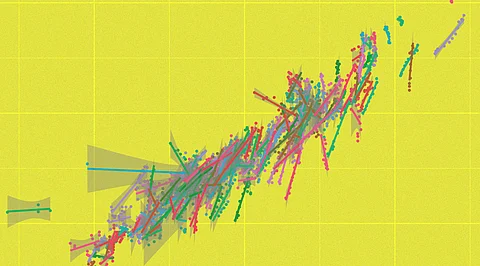

Multilevel modelling is a technique for dealing with grouped or clustered data. Multilevel modelling can also be used to examine data with repeated measures. For example, if we are monitoring the blood pressure of a patient group on a regular basis, the subsequent measures might be thought of as being grouped within the individual subjects. It is capable of handling data with varying measurement times from one element to the next. In such instances, a multilevel model in ML can be used to simulate the parameters that change at more than one level. In this post, we will define multilevel modelling and explain how it works.
Multilevel models in machine learning are statistical models that have a large number of levels of variance. They are also referred to as linear mixed-effect models, hierarchical linear models, mixed models, layered data models, random factors, random effects, random variables, or split-plot patterns.
Many forms of data have a hierarchical or grouped structure, notably observational data collected in human and biomedical research. Kids with the same parents, for example, share more physical and mental features than persons drawn at random from the general population.
People can be further subdivided into geographical areas or authorities such as schools or employers. In longitudinal studies, multilevel data structures emerge when an individual's reactions across time are connected.
Multilevel models, which account for residual elements at each level of the hierarchy, identify the existence of such data hierarchies. A two-level model that facilitates the grouping of outcomes for children inside schools, for example, typically includes residuals at both the child and school stages.
As a result, the residual variance is split into two parts: a between-school component and a within-school component. School residuals, also called school effects, are unobserved school characteristics that influence child outcomes. The connection between outcomes for children is caused by these unknown influences.
In standard multiple regression techniques, the entities of analysis are viewed as independent observations. Because of the failure to recognize hierarchical patterns, standard errors of regressors will be underrepresented, resulting in an overstatement of statistically significant. Ignoring grouping has the biggest impact on prediction errors for higher-level predictor variable values.
The level of grouping in particular outcomes, and also the identification of "outlying" groups, is an important research topic in many situations. For instance, in school performance reviews, the emphasis is on obtaining 'value-added' school effects on kid achievement. Such effects correspond to school-level residuals in a multilevel framework that accounts for prior accomplishment.
To account for group effects, a regular (normal least squares) regression model can be extended with dummy elements for groups. This is referred to as an analysis of variability or fixed-effects framework. In many cases, predictors, like school type, will be specified at the group level (mixed vs. single-sex).
In a fixed-effects model, the impacts of group-level predictors are confused with the implications of group dummies, i.e., it is impossible to separate out effects due to observed and unobserved group features. A multilevel (random effects) model can be used to estimate the impact of both types of variables.
In a multilevel model, the groups in the data set are regarded as a random sample drawn from a community of groups. A fixed-effects model cannot make inferences beyond the units in the dataset.
Floki Inu is Digging its Own Grave Despite Ad Campaign Controversy
Will EU Really Share Its Technology under India, EU Trade and Tech Council?
Fashion in the Metaverse: Will it Take a Nasty Turn Soon?
Cybercriminals are Feasting Over 'Zero-day Hacks' While the World Watches
Top 10 Code Playgrounds Every Web Developer Should Try!
5G Cyberattacks are Menacing! A 9/11 Like Scenario could Unfold Soon
Join our WhatsApp Channel to get the latest news, exclusives and videos on WhatsApp
_____________
Disclaimer: Analytics Insight does not provide financial advice or guidance on cryptocurrencies and stocks. Also note that the cryptocurrencies mentioned/listed on the website could potentially be scams, i.e. designed to induce you to invest financial resources that may be lost forever and not be recoverable once investments are made. This article is provided for informational purposes and does not constitute investment advice. You are responsible for conducting your own research (DYOR) before making any investments. Read more about the financial risks involved here.
